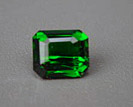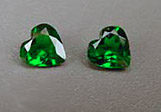



I was prompted to write these comments on chrome diopside after seeing a television shopping network's recent promotion of this gem as "Russian diopside" and their featuring it extensively in rings. Chrome diopside is a rich, emerald green variety of the mineral diopside which derives its color from chromium. A recent Russian find in 1988 is the source of the Tsavorite-like stones that are gaining in popularity and recognition today.
As beautiful as the material is, its use in rings is risky at best. A hardness of (5.5-6), moderate brittleness, and cleavability limit its use to pendants, brooches and earrings unless placed in highly protective settings and given gentle treatment. For these other uses, though, the stone is beautiful and under-appreciated. Good cutting is important as this variety, especially in larger sizes, can be very dark. A good cut with fairly shallow angles can improve brilliance. Cabochons can be distinctive and attractive, and collectors eagerly look for the rare cat'seye form.
A well cut piece of chrome diopside is a beautiful sight to behold, and a reasonably priced alternative to Tsavorite or chrome tourmaline.




The prime value factor for this gem is color, with medium dark green stones at the top. Such a stone in a larger size (2 cts or more) is especially rare since so many larger pieces suffer from light extinction and are too dark. Cat'seye stones bring a premium price. Fine cutting enhances value considerably by adding scintillation and brilliance.